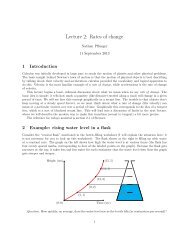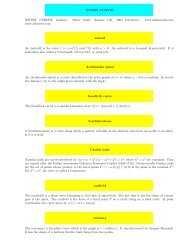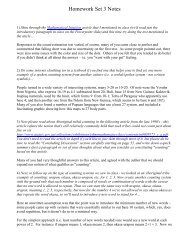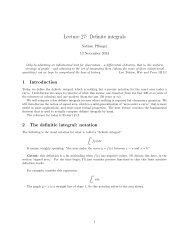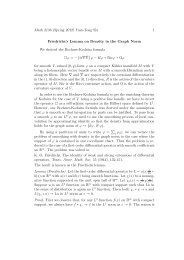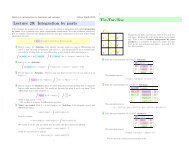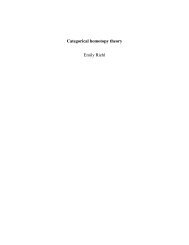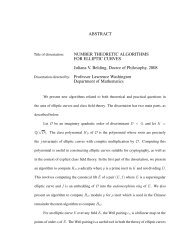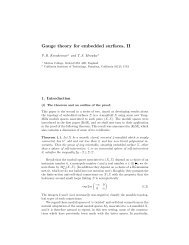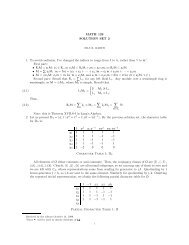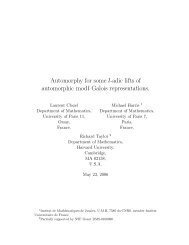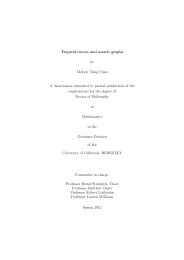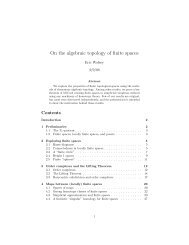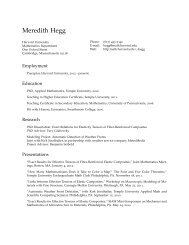"Galois deformation and L-invariant", by Haruzo Hida (5 pages [PDF])
"Galois deformation and L-invariant", by Haruzo Hida (5 pages [PDF])
"Galois deformation and L-invariant", by Haruzo Hida (5 pages [PDF])
You also want an ePaper? Increase the reach of your titles
YUMPU automatically turns print PDFs into web optimized ePapers that Google loves.
GALOIS DEFORMATION AND L-INVARIANT<br />
HARUZO HIDA<br />
1. Lecture 2<br />
Let p>2 be a prime, <strong>and</strong> fix a totally real finite extension F/Q. Forsimplicity,<br />
we assume that p splits completely in F/Q. We start with a <strong>Galois</strong> representation<br />
ρF : Gal(Q/F ) → GL2(W ) associated to a discrete series Hilbert modular form<br />
f (over F ) with coefficients in a finite extension W/Zp (a DVR). We assume the<br />
ordinarity of ρF :<br />
<br />
ρF<br />
∼=<br />
ɛp<br />
|Dp 0<br />
<br />
∗<br />
αp<br />
with ɛp = αp, ɛp|Ip = N k−1 <strong>and</strong> αp(Ip) =1<br />
on the decomposition group <strong>and</strong> the inertial group Ip ⊂ Dp ⊂ Gal(Q/F ) for all<br />
prime factor p of p in F . Here N (σ) ∈ Z × p is the p-adic cyclotomic character with<br />
exp( 2πi<br />
p n ) σ = exp(<br />
N (σ)2πi<br />
pn ) for all n>0 <strong>and</strong> k>1 is an integer. Again for simplicity,<br />
we assume that ρ is unramified outside p. Thus for any prime l ∤ p, writing f|T (l) =<br />
alf, we have Tr(ρ(Frobl)) = al ∈ W . Let K be the quotient field of W (so, K/Qp is<br />
a finite extension).<br />
We consider the universal nearly ordinary <strong>deformation</strong> ρ : Gal(Q/F ) → GL2(R)<br />
over K with the pro-Artinian local universal K-algebra R. This means that for any<br />
Artinian local K-algebra A with maximal ideal mA <strong>and</strong> any <strong>Galois</strong> representation<br />
ρA : Gal(Q/F ) → GL2(A) such that<br />
(K1) unramified outside p;<br />
(K2) ρA| Gal(Qp/Fp) ∼ ∗ ∗<br />
= ( 0 αA,p ) with αA,p ≡ αp mod mA;<br />
(K3) det(ρA) = det ρF ;<br />
(K4) ρA ≡ ρF mod mA,<br />
there exists a unique K-algebra homomorphism ϕ : R → A such that ϕ ◦ ρ ∼ = ρA.<br />
Note that N : Gal(Fp[µp∞]/Fp) ∼ = Z × p (<strong>by</strong> splitting of p in F/Q). Let Γp =1+pZp ⊂<br />
Gal(Fp[µp∞]/Fp). Choose a generator γp of Γp <strong>and</strong> identify W [[Γp]] with W [[Xp]] <strong>by</strong><br />
γp ↔ 1+Xp. Since ρ| Gal(Qp/Fp) ∼ ∗ ∗<br />
= ( 0 δp ), δpα−1 p :Γp → R induces an algebra structure<br />
on R over W [[Xp]]. Thus R is an algebra over K[[Xp]]p|p. If we write ϕ : R → K for<br />
the morphism with ϕ ◦ ρ ∼ = ρF , <strong>by</strong> our construction, Ker(ϕ) ⊇ (Xp)p|p.<br />
Date: May 1, 2006.<br />
The second lecture at Harvard University on 5/1/2006. The author is partially supported <strong>by</strong> an<br />
NSF grant: DMS 0244401 <strong>and</strong> DMS 0456252.<br />
1
GALOIS DEFORMATION AND L-INVARIANT 2<br />
Here is the theorem we have seen in the first lecture:<br />
Theorem 1.1. Suppose R ∼ = K[[Xp]]p|p. Then, if ϕ ◦ ρ ∼ = ρF , for the local Artin<br />
symbol [p, Fp] =Frobp, we have<br />
L(Ind Q<br />
F Ad(ρF<br />
<br />
∂δp([p, Fp])<br />
)) = L(Ad(ρF )) = det<br />
∂Xp ′<br />
<br />
<br />
<br />
logp(γp)αp([p, Fp])<br />
X=0<br />
−1 .<br />
Greenberg proposed a conjectural formula of the L–invariant for a general p-adic<br />
p-ordinary <strong>Galois</strong> representation V with an exceptional zero. When V = Ad(ρF ),<br />
his definition goes as follows. Under some hypothesis, he found a unique subspace<br />
H ⊂ H1 (F, Ad(ρF )) of dimension e = |{p|p}| represented <strong>by</strong> cocycles c : Gal(Q/F ) →<br />
Ad(ρF ) such that<br />
(1) c is unramified outside p;<br />
(2) c restricted to Dp is upper triangular after conjugation for all p|p.<br />
By the condition (2), c|Ip modulo upper nilpotent matrices factors through the cyclotomic<br />
<strong>Galois</strong> group Gal(Qp[µp∞]/Qp) because Fp = Qp, <strong>and</strong> hence c|Dp modulo upper<br />
nilpotent matrices becomes unramified everywhere over the cyclotomic Zp-extension<br />
F∞/F . In other words, the cohomology class [c] is in SelF∞(Ad(ρF )) but not in<br />
SelF (Ad(ρF )).<br />
Take a basis {cp}p|p of H over K. Write<br />
<br />
−ap(σ) ∗<br />
cp(σ) ∼<br />
for σ ∈ Dp<br />
0 ap(σ)<br />
′ with any p′ |p.<br />
Then ap : Dp ′ → K is a homomorphism. His L-invariant is defined <strong>by</strong><br />
<br />
L(Ad(ρF )) = det (ap([p, Fp ′]) p,p ′ <br />
|p logp(γp ′)−1ap([γp ′,Fp ′]))p,p ′ <br />
−1<br />
|p .<br />
The above value is independent of the choice of the basis {cp}p. Then assuming the<br />
following two conditions:<br />
(1) ρ =(ρF mod mW ) is absolutely irreducible over Gal(Q/F [µp]);<br />
(ds) ρss has a non-scalar value over Gal(F p/Fp) for all prime factors p|p,<br />
<strong>by</strong> using a result of Taylor-Wiles <strong>and</strong> Fujiwara (see Fujiwara’s paper: arXiv.math.NT/0602606),<br />
we can prove R ∼ = K[[Xp]], <strong>and</strong> the following conjecture for the arithmetic L-function<br />
is a theorem except for the nonvanishing L(Ad(ρF )) = 0 (see [H00] Theorem 6.3 (4)):<br />
Conjecture 1.2 (Greenberg). Suppose ((ds) <strong>and</strong> that ρ is absolutely irreducible. For<br />
Larith p (s, Ad(ρF )) = Φarith (γs − 1), then Larith p (s, Ad(ρF )) has zero of order equal to<br />
d =[F : Q] <strong>and</strong> for the constant L(Ad(ρF )) ∈ K × specified <strong>by</strong> the determinant as in<br />
the theorem, we have<br />
lim<br />
s→1<br />
Larith p (s, Ad(ρF ))<br />
(s − 1) d<br />
up to units.<br />
p,p ′<br />
= L(Ad(ρF ))E + (Ad(ρF )) |SelQ(Ind Q<br />
F Ad(ρF ) ∗ )| −1/[K:Qp]<br />
p<br />
p
GALOIS DEFORMATION AND L-INVARIANT 3<br />
In the following section, we describe the Selmer group <strong>and</strong> how to define H.<br />
1.1. Selmer Groups. We recall Greenberg’s definition of Selmer groups. Write<br />
F (p) /F for the maximal extension unramified outside p <strong>and</strong> ∞. Put G = Gal(F (p) /F )<br />
<strong>and</strong> GM = Gal(F (p) /M ). Let V = Ad(ρF ) with a continuous action of G. We fix a<br />
W -lattice T in V stable under G.<br />
Write D = Dp ⊂ G for the decomposition group of each prime factor p|p. Choosing<br />
a basis of ρF so that ρF |D is upper triangular. We have a 3-step filtration:<br />
(ord) V ⊃F − p V ⊃F + p V ⊃{0},<br />
where taking a basis so that ρF |D is upper triangular, F − p V is made up of upper<br />
triangular matrices <strong>and</strong> F + p V is made up of upper nilpotent matrices, <strong>and</strong> on<br />
F − p V/F + p V , D acts trivially (getting eigenvalue 1 for Frobp). Since V is self-dual, its<br />
dual V ∗ (1) = HomK(V,K) ⊗N again satisfies (ord).<br />
Let M/F be a subfield of F (p) , <strong>and</strong> put GM = Gal(F (p) /M ). We write p for a<br />
prime of M over p <strong>and</strong> q for general primes of M. We put<br />
Lp(V ) = Ker(Res : H 1 (Mp,V) → H 1 (Ip,<br />
V<br />
F + p (V ) )).<br />
Then for a GM-stable W -lattice T of V , we define for the image Lp(V/T)ofLp(V )<br />
in H 1 (Mp,V/T)<br />
(1.1) SelM(A) = Ker(H 1 (GM,A) → <br />
p<br />
H1 (Mp,A)<br />
)) for A = V,V/T.<br />
Lp(A)<br />
The classical Selmer group of V is given <strong>by</strong> SelM(V/T), equipped with discrete topology.<br />
Write F∞ for the cyclotomic Zp–extension of F . We define “−” Selmer group<br />
replacing Lp(A) <strong>by</strong><br />
L − p (V ) = Ker(Res : H 1 (Mp,V) → H 1 (Ip,<br />
V<br />
F − p (V ) )).<br />
Lemma 1.3. Suppose R ∼ = K[[Xp]]p|p. Then Sel −<br />
F (V ) ∼ = HomK(mR/m2 R ,K) <strong>and</strong><br />
SelF (V )=0.<br />
Proof. We consider the space DerK(R, K) of continuous K-derivations. Let K[ε] =<br />
K[t]/(t2 ) for the dual number ε =(t mod t2 ). Then writing K-algebra homomorphism<br />
φ : R → K[ε] asφ(r) =φ0(r)+φ1(r)ε <strong>and</strong> sending φ to φ1 ∈ DerK(R, K), we<br />
have HomK-alg(R, K[ε]) ∼ = DerK(R, K) = HomK(mR/m2 R ,K). By the universality of<br />
(R, ρ), we have<br />
HomK-alg(R, K[ε]) ∼ = {ρ : Gal(Q/F ) → GL2(K[ε])|ρ satisfies the condtions (K1–4)}<br />
∼=<br />
.<br />
Pick ρ as above. Write ρ(σ) =ρ0(σ)+ρ1(σ)ε. Then cρ = ρ1ρ −1<br />
F<br />
can be easily checked<br />
to be a 1-cocycle having values in M2(K) ⊃ V . Since det(ρ) =det(ρF ) ⇒ Tr(cρ) =0,
GALOIS DEFORMATION AND L-INVARIANT 4<br />
cρ has values in V . By the reducibility condition (K2), [cρ] ∈ Sel −<br />
F (V ). We see easily<br />
that ρ ∼ = ρ ′ ⇔ [cρ] =[cρ ′]. We can reverse the above argument starting a cocycle c<br />
giving an element of Sel −<br />
F (V ) to construct a <strong>deformation</strong> ρc with values in K[ε]. Thus<br />
we have<br />
{ρ : Gal(Q/F ) → GL2(K[ε])|ρ satisfies the condtions (K1–4)}<br />
∼ =<br />
∼= Sel −<br />
F (V ).<br />
Since the algebra structure of R over W [[Xp]]p|p is given <strong>by</strong> δpα −1<br />
p , the K-derivation<br />
δ : R → K corresponding to a K[ε]-<strong>deformation</strong> ρ is a W [[Xp]]-derivation if <strong>and</strong> only<br />
if ρ1| Gal(F ∼ ( p/Fp) ∗∗<br />
00), which is equivalent to [cρ] ∈ SelF (V ), because we already knew<br />
that Tr(cρ) = 0. Thus we have SelF (V ) ∼ = DerW [[Xp]](R, K) =0. <br />
We also have<br />
Lemma 1.4.<br />
(V) SelF (V )=0⇒ H 1 (G,V) ∼ = <br />
p<br />
H1 (Fp,V)<br />
.<br />
Lp(V )<br />
Indeed, <strong>by</strong> the Poitou-Tate exact sequence, the following sequence is exact:<br />
SelF (V ) → H 1 (GM,V) → <br />
p<br />
H 1 (Fp,V)<br />
Lp(V ) → SelF (V ∗ (1)) ∗ .<br />
It is an old theorem of Greenberg that dim SelF (V ) = dim SelF (V ∗ (1)) ∗ (see [G]<br />
Proposition 2); so, we have the assertion (V). <br />
2. Greenberg’s L–invariant<br />
Here is Greenberg’s definition of L(V ): The long exact sequence of F − p V/F + p V ↩→<br />
V/F + p V ↠ V/F − p V gives a homomorphism, noting Fp = Qp,<br />
Note that<br />
H 1 (Fp, F − p V/F + p V ) = Hom(G ab<br />
Qp , F − p V/F + p V ) ιp<br />
−→ H 1 (Fp,V)/Lp(V ).<br />
Hom(G ab<br />
Qp , F − p V/F + p V ) ∼ = (F − p V/F + p V )2 ∼ = K 2<br />
canonically <strong>by</strong> φ ↦→ ( φ([γ,Fp])<br />
log p (γ) ,φ([p, Fp])). Here [x, Fp] = [x, Qp] is the local Artin<br />
symbol (suitably normalized). Since<br />
Lp(F − p V/F + p V ) = Ker(H 1 (Fp, F − p V/F + p V ) Res<br />
−−→ H 1 (Ip, F − p V/F + p V )),<br />
the image of ιp is isomorphic to F − p V/F + p V ∼ = K. By (V), we have a unique subspace<br />
H of H1 (G,V) projecting down onto<br />
<br />
Im(ιp) ↩→ <br />
p<br />
p<br />
H1 (Fp,V)<br />
.<br />
Lp(V )
GALOIS DEFORMATION AND L-INVARIANT 5<br />
Then <strong>by</strong> the restriction, H gives rise to a subspace L of<br />
<br />
Hom(G ab<br />
Fp<br />
p<br />
, F − p V/F + p V ) ∼ = <br />
(F<br />
p<br />
− p V/F + p V )2<br />
isomorphic to <br />
p (F − p V/F + p V ). If a cocycle c representing an element in H is unrami-<br />
fied, it gives rise to an element in SelF (V ). By the vanishing of SelF (V ) (Lemma 1.3),<br />
this implies c = 0; so, the projection of L to the first factor <br />
p (F − p V/F + p V ) (via<br />
φ ↦→ (φ([γ,Fp])/ logp(γ))p) is surjective. Thus this subspace L is a graph of a K–linear<br />
map L : <br />
p F − p V/F + p V → <br />
p F − p V/F + p V . We then define L(V ) = det(L) ∈ K.<br />
Let ρ : GF → GL2(R) be the universal nearly ordinary <strong>deformation</strong> with ρ =<br />
<br />
D<br />
∗ ∗<br />
0 δ<br />
. Then cp = ∂ρ −1<br />
|X=0ρ<br />
∂Xp F is a 1-cocycle (<strong>by</strong> the argument proving Lemma 1.3)<br />
giving rise to a class of H. By Lemma 1.3, H = Sel −<br />
F (V ), <strong>and</strong> {cp}p gives a basis of H<br />
over K. We have δ([u, Fp]) = (1 + Xp) logp(u)/ logp(γ) × for u ∈ O p = Z × p . Writing<br />
<br />
−ap(σ) ∗<br />
cp(σ) =<br />
ρF (σ)<br />
0 ap(σ)<br />
−1 ,<br />
−1 dδ<br />
we have ap = δ dXp |X=0, <strong>and</strong> from this we get the desired formula of L(Ad(ρF )).<br />
If one restricts c ∈ H to G∞ = Gal(F (p) /F∞), its ramification is exhausted <strong>by</strong><br />
Γ=Gal(F∞/F ) (because Fp = Qp) giving rise to a class [c] ∈ SelF∞(V ). The kernel<br />
of the restriction map: H1 (G,V) → H1 (G∞,V) is given <strong>by</strong> H1 (Γ,H0 (G∞,V)) = 0<br />
because H0 (G∞,V) = 0. Thus the image of H in SelF∞(V/T) gives rise to the order<br />
d exceptional zero of Larith (s, Ad(ρF )) at s = 1. We have proved<br />
Proposition 2.1. For the number of prime factors d =[F : Q] of p in F , we have<br />
ords=1 L arith<br />
p (s, Ad(ρF )) ≥ d.<br />
References<br />
[G] R. Greenberg, Trivial zeros of p–adic L–functions, Contemporary Math. 165 (1994),<br />
149–174<br />
[GS] R. Greenberg <strong>and</strong> G. Stevens, p-adic L–functions <strong>and</strong> p–adic periods of modular forms,<br />
Inventiones Math. 111 (1993), 407–447<br />
[H00] H. <strong>Hida</strong>, Adjoint Selmer groups as Iwasawa modules, Israel Journal of Math. 120 (2000),<br />
361–427<br />
[MFG] H. <strong>Hida</strong>, Modular Forms <strong>and</strong> <strong>Galois</strong> Cohomology, Cambridge Studies in Advanced Mathematics<br />
69, 2000, Cambridge University Press


!["Galois deformation and L-invariant", by Haruzo Hida (5 pages [PDF])](https://img.yumpu.com/17872853/1/500x640/quotgalois-deformation-and-l-invariantquot-by-haruzo-hida-5-pages-pdf.jpg)
